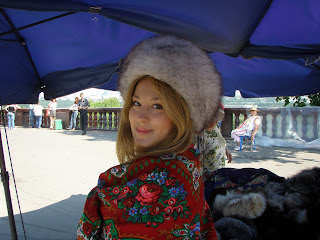 We are at Moscow's Domodedovo airport, after a really intense week, ready to board our British Airways flight to London. While I look through the windows at the waiting lounge I realize what an exciting place for plane spotting can a Russian airport be. At Barcelona airport, for example, around 95% of the planes are either Boeing 737 and those of the Airbus 320 family, in airports with a large number of long haul flights, like Heathrow you can also see Boeing 747s and 777s and 767s or Airbus 340s and 330s. But at a Russian airport you can see all of these plus a whole range of old soviet-era planes, new Russian planes and second-hand Western planes. This picture is a great example of the situation of aviation in Russia.
We are at Moscow's Domodedovo airport, after a really intense week, ready to board our British Airways flight to London. While I look through the windows at the waiting lounge I realize what an exciting place for plane spotting can a Russian airport be. At Barcelona airport, for example, around 95% of the planes are either Boeing 737 and those of the Airbus 320 family, in airports with a large number of long haul flights, like Heathrow you can also see Boeing 747s and 777s and 767s or Airbus 340s and 330s. But at a Russian airport you can see all of these plus a whole range of old soviet-era planes, new Russian planes and second-hand Western planes. This picture is a great example of the situation of aviation in Russia.Let's have a closer look: in the foreground an old soviet-era Tupolev 134 of Rossiya Airlines, next to it an Airbus 310 of S7-Sibir Airlines, one of the largest domestic airlines in Russia. The A-310 although not a particularly old model is hard to see in Western airports as it was not as commercially successful as the A-320 and A-330 models. Further away is another S7 plane, an Airbus of the A320 family. Russian airlines have been adding new Boeing and Airbus planes that are progressively replacing the old soviet models.
We can also see 2 planes from Transaero, Russia's second international airline (the first is Aeroflot), a Boeing 767 (right) and a Boeing 747-200 Jumbo (left), two wide-body long range planes that probably transport Russian tourists to resorts in the Mediterranean, that are popular destinations from Domodedovo.
In the background there is a large number of parked planes and, although it is difficult to tell from this picture, they are mostly soviet-built. For example, just behind the tail of the S7 Airbus 310 there is an Ilushyn IL-96, the Russian equivalent to the Airbus 340, of relatively new design, but that has experienced some problems that have prevented it from selling in larger numbers.
In summary, quite an interesting mix, that is probably going to become more homogeneous, as Russian carriers update their fleets, but as the restructured Russian aircraft industry gets back to the market with new models, it might continue to be more diverse than in the West.

























